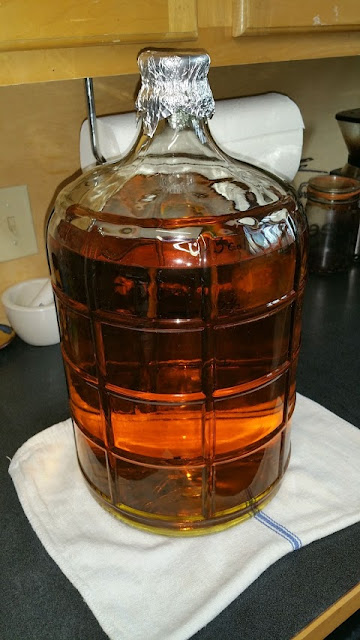Raspberries do very well in Alaska. I wash fresh picked berries and freeze them on sheet pans and then weigh out 1 pound and vacuum bag the frozen berries for storage in my deep freezer. I needed to make room in my little deep freezer for this season's produce so I pulled out 16 bags of frozen Raspberries to make a 5 gallon batch of Raspberry Wine.
On 8/24/2021 I combined the following ingredients:
16 lbs frozen Raspberries
10 lbs Sugar - dissolved in 3 Gal hot water
1/4 tsp Potassium Metabisulfite
2 1/2 tsp Pectic Enzyme
5 tsp Yeast Nutrient
2 1/2 tsp Acid Blend
1 1/4 tsp Grape Tannin
I added 2 Qts hot tap water to = about 6 Gals total must at 64 degrees F.
Let rest 24 hours before adding yeast.
On 8/25 The Specific Gravity reading was 1.090
I added 20 oz. sugar dissolved in 2 cups hot water to bring starting Specific Gravity up to 1.10
Total volume is about 6 1/2 gallons of must with pulp.
I rehydrated 1 package of Lalvin EC-1118 wine yeast in 1 cup of warm water and pitched the yeast. After 30 hours I was not seeing any activity, probably due to my 68 F cool temperature, so on 8/27 I added a second package of Lalvin EC-1118 yeast. I just sprinkled the dry yeast on top and did see fermentation activity within 24 hrs.
I stir the must daily and push down the floating cap for optimal color and flavor extraction. I will check the specific gravity readings and when fermentation slows down I will press the pulp and rack into a carboy.
On Saturday 9/11 - 17 days after pitching the yeast the Specific Gravity was 1.034 and the temperature is about 67 F.
On Saturday 9/18 - 24 days after pitching the yeast the Specific Gravity was 1.010 and the temperature was 66 F,
On Sunday 9/19 - I pressed the pulp....
...and transferred to a 5 Gal. glass carboy.
I got about 5 1/2 Gal. of new wine.


































